 Okay. Today I’m going to set facts and information aside, and write something that wells up from the cool, clear spring deep in my heart. I want to offer a sip of that which has driven me to love nature so intensely over a lifetime, and guides my path to this day. See if perhaps there’s something that resonates with you here.
Okay. Today I’m going to set facts and information aside, and write something that wells up from the cool, clear spring deep in my heart. I want to offer a sip of that which has driven me to love nature so intensely over a lifetime, and guides my path to this day. See if perhaps there’s something that resonates with you here.
I teach and write about a lot of different natural history related topics, from foraging to ecopsychology to invasive species. It allows me to share some of the cool things I’ve learned about over the years, and connect with others over our mutual interests. But if I had to pick one topic that I enjoy the most, it has to be nature identification. After all, that’s the core of the first naturalist class I started teaching years ago: showing everyday people some tools and skills to help them identify animals, plants, and fungi. It’s where I got my start as a naturalist over a decade ago, and it weaves into so much of what I do now.
On the surface, there’s the practical-mental component of it. You need to be able to know the process for being able to put a name to an organism you’ve never met before, which involves observing its physical characteristics, comparing them to sources like field guides and ID apps, and then choosing the best option according to your reasoned judgement. You also need to commit it to memory so that the next time you see this being you remember what it is. (Or, if you’re like me and have a spotty memory, how to re-find the identification after saying “AHHHH, I’ve SEEN this before, I KNOW the name, I just can’t REMEMBER IT!”)
But I have a motivation that goes deeper than that surface understanding. I want people to feel emotional investment in the beings they’re identifying. I want them to feel that thrill of being able to say “Yes! I know this one!”, not just as a personal victory, but as a connection to another living being that just happens to not be human.
 See, when you first start practicing identification, you might be able to truthfully say you love nature, but feel that there’s a wall between you and those unfamiliar beings because you don’t know what they are. Or maybe you’re really interested in animals, but plants seem like a monotonous green curtain to you. Identification starts to break down those barriers, like learning the first few words and phrases of a new language.
See, when you first start practicing identification, you might be able to truthfully say you love nature, but feel that there’s a wall between you and those unfamiliar beings because you don’t know what they are. Or maybe you’re really interested in animals, but plants seem like a monotonous green curtain to you. Identification starts to break down those barriers, like learning the first few words and phrases of a new language.
The more species you’re able to recognize, the more you feel like you know them, at least a little bit. It’s a starting point, after all. Now that you know their names, you can read books, articles, and websites about them, watch documentaries, and otherwise delve into theoretical knowledge. You also know why this being is different from this other species over here, so that when you observe them in nature you can categorize the behavior and traits you see accordingly. All this helps you begin to put together a more nuanced, three-dimensional picture of each species you’ve identified.
And then–you find that you care about these beings. You’re emotionally invested in them. You love nature more because it now has faces and names and personalities. Identifying a new being is no longer simply writing a name in a spreadsheet, but the recognition of one individual living being to another, a commitment to memory of a member of your wider natural community.
 So you dig deeper. You learn more about the habits and habitats of the beings you’ve met, the complex ecosystems they’re a part of, the other beings they have interrelationships with, whether beneficial or destructive. You find out the best ways to interact with them so that you do them no harm, but also enrich your understanding. And that invariably leads to finding out about what threatens them, how close they are to the brink of extinction, and what can be done to help them survive in an increasingly ecologically chaotic world.
So you dig deeper. You learn more about the habits and habitats of the beings you’ve met, the complex ecosystems they’re a part of, the other beings they have interrelationships with, whether beneficial or destructive. You find out the best ways to interact with them so that you do them no harm, but also enrich your understanding. And that invariably leads to finding out about what threatens them, how close they are to the brink of extinction, and what can be done to help them survive in an increasingly ecologically chaotic world.
To know nature is to love nature, if you allow yourself that emotional vulnerability. Sure, countless people have learned enough about trees to know which ones are most commercially viable as timber; they know enough about the ocean to be able to drop a net into the right place to haul up boatloads of gasping, struggling fish for the market. And yes, some of them do love nature in their own way, even as they exploit it.
But I want to challenge people to know it more deeply, personally, vulnerably. Not just as dollar signs and basic facts, not just as a vague feeling of love and joy when they set foot into a forest or sail out onto the waves, but as entering into a greater domain where it’s not just all about us. Identifying nature for the simple sake of knowing nature circumvents those distractions of profit and resource extraction. We do the thing for its intrinsic, not extrinsic, value.
The beauty of it is that identification is accessible to just about anyone. The resources used in learning the names of beings–and the names themselves–vary from place to place. But each of us has that opportunity to reach out, even if it starts with just one single species. There’s no schedule you have to stick to, no minimum number of species you must know in order to be deemed acceptable.*
 So I invite you to join me in opening ourselves up to the wider community of nature, of which we are just one species among multitudes. Start with names, like you would with any other introduction, and see where that leads you. It’s only appropriate that things would then unfold organically, at no particular pace but that which you yourself set as you go. Along the way, allow your heart to open up to these other precious, amazing beings we share this immense and tiny world with, even if it can be scary and overwhelming at times. To know nature is to love nature, and in my experience, that connection has been worth all the trouble.
So I invite you to join me in opening ourselves up to the wider community of nature, of which we are just one species among multitudes. Start with names, like you would with any other introduction, and see where that leads you. It’s only appropriate that things would then unfold organically, at no particular pace but that which you yourself set as you go. Along the way, allow your heart to open up to these other precious, amazing beings we share this immense and tiny world with, even if it can be scary and overwhelming at times. To know nature is to love nature, and in my experience, that connection has been worth all the trouble.
* With the exception, of course, of those of you taking classes that require you to identify a certain number of things, like ten species from each genus studied in a botany class. However, on your own personal time, you’ve got no minimums or limits on your identification activities, just like everyone else.
